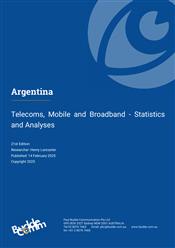Argentina Telecoms Market Report
Telecoms, Mobile and Broadband - Statistics and Analyses

Argentina’s telecom regulator releases ARS671.6 million to boost national broadband connectivity
Argentina’s ongoing problem with hyperinflation continues to distort the telecom market’s performance, which shows strong growth in revenue but only modest gains in subscriber numbers each year. The country’s economic challenges have been exacerbated since 2020 by the Covid-19 pandemic and the resultant austerity measures, coupled with a drought, lower export sales, and an economic slowdown in Brazil – Argentina’s main trading partner.
Nevertheless, the mobility restrictions, rising unemployment, and an overall decline in productivity have had a minimal adverse effect on the telecom sector. Fixed-line teledensity continues on its slow, gradual decline year upon year, but at a much gentler pace than has been seen in other parts of the world. The fixed broadband segment has penetration levels only slightly higher than the fixed-line teledensity; nearly a quarter of the country’s broadband connections are via DSL, although fibre is starting claim an increasing share of that market as networks expand across most of the main cities.
Mobile broadband continues to be the preferred platform for internet access, supported by high mobile penetration levels and nationwide LTE coverage. The first 5G service was launched in February 2021 using re-farmed LTE frequencies. The anticipated 5G spectrum auctions should drive even stronger uptake in mobile broadband services.
While the various fixed, mobile, and cable operators push to expand and enhance their services, the government is also making an active contribution towards boosting broadband connectivity around the country. Its national connectivity plan ‘Plan Conectar’, launched in September 2020, provides funding for a range of programs to increase coverage. In August 2021, the telecom regulator announced the release of a further ARS671.6 million in funding to help operators accelerate the rollout of their broadband infrastructure and services.
This report includes the regulator's market data to June 2021, telcos' financial and operating data updates to Q3 2021, Telecom Maturity Index charts and analyses, assessment of the global impact of Covid-19 on the telecoms sector, and other recent market developments.
Key developments:
- Argentina’s government declares TV, internet, and mobile as being essential public services, preventing operators from raising prices.
- ARSAT given access to 4,405km of disused fibre infrastructure spanning 14 provinces;
- 5G is launched by Telecom Personal using Dynamic Spectrum Sharing (DSS) on re-farmed LTE frequencies.
- Ministry of Public Innovation approves passive infrastructure sharing regulations.
- Regulator launches consultation on the use and allocation of the 6GHz band for Wi-Fi services.
- Roaming charges are abolished between Argentina and Chile.
- Movistar and IBM launch Open RAN proof of concept network in Puerto Madryn.
- Telecom Argentina to phase out its Fibertel and Cablevisión brands, integrating them into the Personal and Flow brands respectively.
- GlobeNet’s 2,500km Malbec submarine system linking Rio de Janeiro with Buenos Aires is lit.
Companies mentioned in this report:
Movistar, Telefónica de Argentina, Telecom Argentina, Grupo Clarín, Claro, Telmex, Telecom Personal, Nextel Argentina, IPLAN, ARSAT, Cablevisión, VeloCom, Fibrenet, Arnet, MercadoLibre.
Related Reports
- Latin America - Fixed Broadband Market - Statistics and Analyses
- Latin America - Mobile Network Operators and MVNOs
- Caribbean - Telecoms, Mobile and Broadband - Statistics and Analyses
- Costa Rica - Telecoms, Mobile and Broadband - Statistics and Analyses
- Ecuador - Telecoms, Mobile and Broadband - Statistics and Analyses
- Guatemala - Telecoms, Mobile and Broadband - Statistics and Analyses
- Uruguay - Telecoms, Mobile and Broadband - Statistics and Analyses
- Peru - Telecoms, Mobile and Broadband - Statistics and Analyses
- Brazil - Telecoms, Mobile and Broadband - Statistics and Analyses
Share this Report
TMT Intelligence
A platform to scale your intelligence tasks
Monitor critical insights with our AI-powered Market Intelligence Platform gathering and analyzing intelligence in real time. With AI trained to spot emerging trends and detect new strategic opportunities, our clients use TMT Intelligence to accelerate their growth.
If you want to know more about it, please see:
Research Methodology
BuddeComm's strategic business reports contain a combination of both primary and secondary research statistics, analyses written by our senior analysts supported by a network of experts, industry contacts and researchers from around the world as well as our own scenario forecasts.
For more details, please see:
More than 4,000 customers from 140 countries utilise BuddeComm Research
Are you interested in BuddeComm's Custom Research Service?
Hot Topics
News & Views
Have the latest telecommunications industry news delivered to your inbox by subscribing to BuddeComm's weekly newsletter.